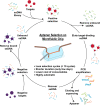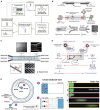The Application of Microfluidic Technologies in Aptamer Selection
- PMID: 34604229
- PMCID: PMC8484746
- DOI: 10.3389/fcell.2021.730035
The Application of Microfluidic Technologies in Aptamer Selection
Abstract
Aptamers are sequences of single-strand oligonucleotides (DNA or RNA) with potential binding capability to specific target molecules, which are increasingly used as agents for analysis, diagnosis, and medical treatment. Aptamers are generated by a selection method named systematic evolution of ligands by exponential enrichment (SELEX). Numerous SELEX methods have been developed for aptamer selections. However, the conventional SELEX methods still suffer from high labor intensity, low operation efficiency, and low success rate. Thus, the applications of aptamer with desired properties are limited. With their advantages of low cost, high speed, and upgraded extent of automation, microfluidic technologies have become promising tools for rapid and high throughput aptamer selection. This paper reviews current progresses of such microfluidic systems for aptamer selection. Comparisons of selection performances with discussions on principles, structure, operations, as well as advantages and limitations of various microfluidic-based aptamer selection methods are provided.
Keywords: SELEX; aptamer; microarray; microfluidics; oligonucleotide.
Copyright © 2021 Liu, Wang, Chan, Lu, Yu, Zhang and Ren.
Conflict of interest statement
The authors declare that the research was conducted in the absence of any commercial or financial relationships that could be construed as a potential conflict of interest.
Figures




Similar articles
-
Aptamer selection via versatile microfluidic platforms and their diverse applications.Lab Chip. 2025 Feb 25;25(5):1047-1080. doi: 10.1039/d4lc00859f. Lab Chip. 2025. PMID: 39774569 Review.
-
New Technologies Provide Quantum Changes in the Scale, Speed, and Success of SELEX Methods and Aptamer Characterization.Mol Ther Nucleic Acids. 2014 Aug 5;3(8):e183. doi: 10.1038/mtna.2014.34. Mol Ther Nucleic Acids. 2014. PMID: 25093707 Free PMC article.
-
A comparative study of aptamer isolation by conventional and microfluidic strategies.Analyst. 2023 Feb 13;148(4):787-798. doi: 10.1039/d2an01767a. Analyst. 2023. PMID: 36688616 Free PMC article.
-
[Efficient screening for 8-oxoguanine DNA glycosylase binding aptamers via capillary electrophoresis].Se Pu. 2021 Jul 8;39(7):721-729. doi: 10.3724/SP.J.1123.2020.12017. Se Pu. 2021. PMID: 34227370 Free PMC article. Chinese.
-
Generating aptamers by cell-SELEX for applications in molecular medicine.Int J Mol Sci. 2012;13(3):3341-3353. doi: 10.3390/ijms13033341. Epub 2012 Mar 12. Int J Mol Sci. 2012. PMID: 22489154 Free PMC article. Review.
Cited by
-
Controlled Nanoconfinement in a Microfluidic Modular Bead Array Device via Elastomeric Diaphragm Collapse for Enhancing Biomolecular Binding Kinetics.Small. 2025 Aug;21(34):e2412474. doi: 10.1002/smll.202412474. Epub 2025 Apr 17. Small. 2025. PMID: 40244082 Free PMC article.
-
Aptamers Enhance Oncolytic Viruses' Antitumor Efficacy.Pharmaceutics. 2022 Dec 31;15(1):151. doi: 10.3390/pharmaceutics15010151. Pharmaceutics. 2022. PMID: 36678780 Free PMC article. Review.
-
Microfluidic synthesis as a new route to produce novel functional materials.Biomicrofluidics. 2022 Aug 24;16(4):041301. doi: 10.1063/5.0100206. eCollection 2022 Jul. Biomicrofluidics. 2022. PMID: 36035887 Free PMC article.
-
AI-optimized electrochemical aptasensors for stable, reproducible detection of neurodegenerative diseases, cancer, and coronavirus.Heliyon. 2024 Dec 18;11(1):e41338. doi: 10.1016/j.heliyon.2024.e41338. eCollection 2025 Jan 15. Heliyon. 2024. PMID: 39834418 Free PMC article. Review.
-
[Advances in exosome-targeting aptamer-screening techniques].Se Pu. 2025 May;43(5):424-433. doi: 10.3724/SP.J.1123.2024.10029. Se Pu. 2025. PMID: 40331607 Free PMC article. Review. Chinese.
References
Publication types
LinkOut - more resources
Full Text Sources

